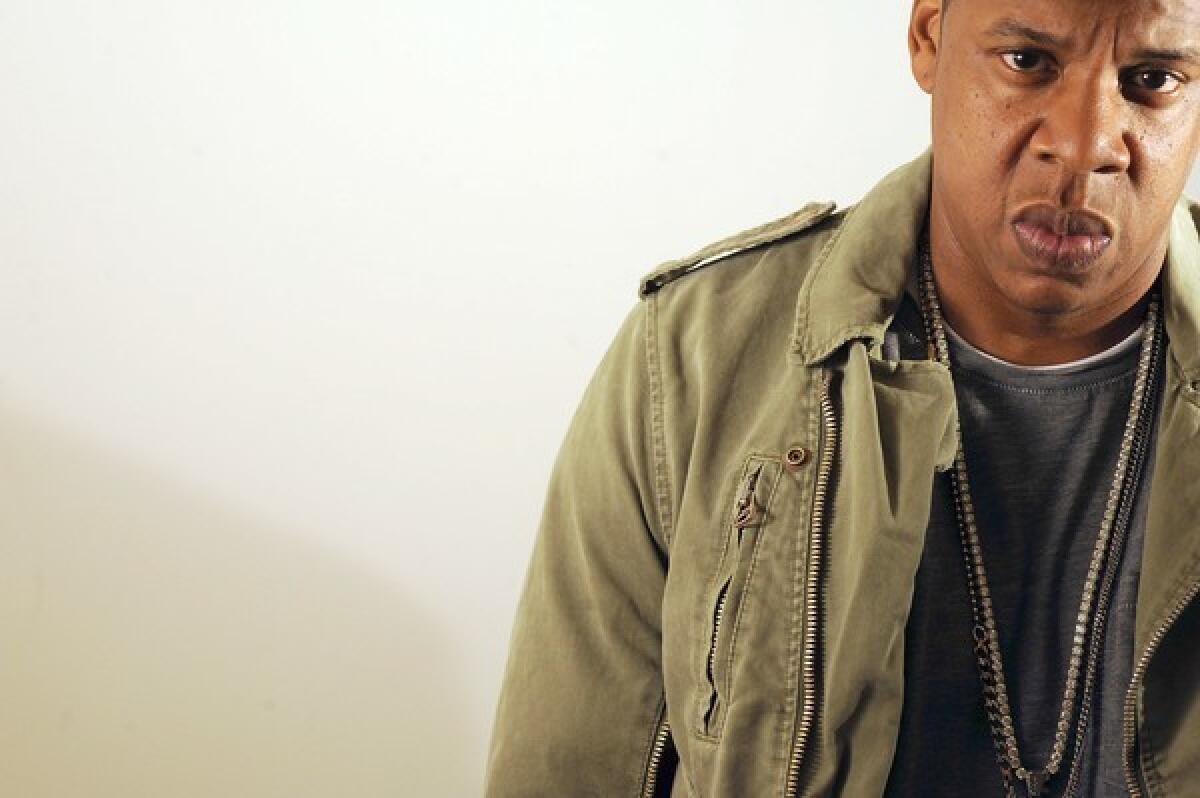Jay-Z widens the festival tent

The plan was to rock the mike, not cause an identity crisis.
In 2008, when Jay-Z was named as a headlining act for Britain’s fiercely rock-centric Glastonbury Festival -- a first for any hip-hop performer, let alone one of rap’s epochal superstars -- the island nation erupted in furious debate. They’re giving a rapper domain over one of rock’s elite events? Critics derided the decision as “a disaster” and “tragic,” assailing Glastonbury itself as “contaminated.” No less an eminence than Noel Gallagher of the Brit-pop quintet Oasis provided an antagonistic voice of dissent. “I’m sorry, but Jay-Z? No chance,” Gallagher said in an interview with the BBC, citing the festival’s “history of guitar music.”
To Jay (birth name: Shawn Corey Carter), the situation smacked of segregation. “That was the old guard standing in the way, saying, ‘This is rock music. This is sacred,’ ” he said, seated in his wood-lined corner office, a stone’s throw from Times Square. “It was one of those hurdles we had to break down.”
B-boy braggadocio is one thing, but a certain performance anxiety set in when the rapper first laid eyes on Glastonbury’s heaving masses: nearly a quarter-million festival-goers camped out in a vast tent city surrounding the outdoor venue in the British countryside. Around 70,000 of them -- some openly hostile -- awaited his set.
“It felt like we were invading a country,” Jay said. “ ‘Whoa. There’s a lot of people out there.’ I had never played before that many people in my life. ‘What did we just do? This had better work.’ ”
Not only did he manage to win over the crowd -- thanks, in part, to his opening number, a cheeky cover of Oasis’ biggest hit, “Wonderwall” -- but the artist known variously as Jigga Man and Young Hova in the process established a whole new enterprise. With what he calls his Glastonbury “game-changer,” Jay-Z suddenly became the most internationally popular live performer in hip-hop history.
As a measure of his post-Glastonbury clout, this year Jay will take his show on the road to such top-tier summer music fests as Tennessee’s Bonnaroo Music & Arts Festival, the Summer Sonic Festival in Japan and Germany’s Rock Am Ring, among others. And come Friday, Jay-Z arrives as the first straight-up rapper to claim a headlining berth at Southern California’s crowning musical event: the Coachella Valley Music & Arts Festival in Indio. Others have graced the lineup -- Jurassic 5, Kool Keith, MURS, Kanye West and Aesop Rock, to name a few -- but none have done it at the top of the ticket.
“In hip-hop, there’s not many great performers,” Jay-Z acknowledged. “I look outside the genre, measuring myself against others. I look at Madonna’s production and envy that. Daft Punk’s set, I’m like, what the. . . . And I look at the way U2 can command an audience. Bono’s a performer pretty much like I am. He’s not a dancer; he’s not jumping around. He’s having a conversation. He’s using his stillness as movement.”
To be sure, such platinum-anointed MCs as 50 Cent and Lil Wayne can book arena tours and rock stadiums while never entirely crossing beyond their “urban” core audiences. Eminem remains a huge international draw but has until very recently resisted the lure of the festival stage. And West enraged fans when he headlined Bonnaroo 2008 by refusing to take the stage until just before sunrise.
But as Coachella’s founder and operational mastermind Paul Tollett points out, Jay-Z is the only rhyme-spitter in the game today with enough big hits, street cred, Twitter-worthy showmanship and mass appeal to connect with the desert festival’s discerning audience. “I don’t think there’s any other hip-hop artist who could headline Coachella right now,” Tollett said.
Moreover, at a precarious time in the live music biz, organizers are looking to Hovi Baby as a solution.
“Jay-Z is more than a rapper,” said Ebro Darden, programming director of New York’s influential urban radio station Hot 97 FM. “People forget he has a platinum rock album -- the mash-up thing he did with Linkin Park. He has done songs with Chris Martin and performed with Coldplay many times. Then add in [Jay’s] high profile and the big intangible: People believe what he’s saying in his music. He’s authentic.”
‘Horrible performer’
Time was when it was enough for Jay-Z, 40, to flex his drawing power in ways that didn’t necessarily put him in dramatic confrontation with the rock ‘n’ roll firmament.
The well-known facts: He’s topped the national album chart 11 times in a 15-year career and created many of the most anthemic street bangers of the modern hip-hop era: “Hard Knock Life (Ghetto Anthem),” “Big Pimpin’ ” and last year’s “Empire State of Mind” (featuring Alicia Keys) among them. He retired from performing in 2004 after an ill-fated co-headlining tour with R&B superstar R. Kelly fell apart midstream, and assumed presidency of his label, Island Def Jam (before the inevitable Michael Jordan-like “Adios retirement!” moment in 2006). He married R&B royalty, Beyoncé Knowles, in a hush-hush ceremony last year. Then he capped it all off by signing one of the most lucrative contracts in the history of pop: -- a deal with Live Nation worth $150 million.
After erupting from Brooklyn’s rough-and-tumble Marcy Housing Projects to break through as a recording artist in 1996, Jigga’s initial efforts as a showman were probably better intended than received. “All my early years? Forget it. I was a horrible performer,” Jay said, admitting he learned it the hard way from DMX during a co-headlining tour in 1998. “DMX tore me to pieces. I remember being stunned.”
Through a combination of competitive urgency and the kind of icy professionalism for which he has become known, Jay-Z diagnosed what needed to be done. Namely, highlighting his nimble lyricism by frequently rapping a cappella and executing blustery moves like running through the audience while delivering rhymes that raised the bar on DMX’s macho, shirt-off stage posturing.
“He had me really working. But I had to figure this out,” the rapper continued. “If you want to be a headliner, you better put on a headline show.”
That philosophy has meant giving up most live rap acts’ typical indulgence -- being accompanied by a two-track of recorded music -- in favor of touring with a 10-piece backing band (a three-member horn section, two guitarists, keyboardists, two drummers and backup MC Memphis Bleek). This shift is prompted as well by new music that feels bigger and features a narrator who, as on “Run This Town” and “Empire State of Mind,” is clearly speaking from a position of authority.
In these new surroundings, Jay is careful to not lose track of the chief difference between rocking an arena as a solo artist and being just one part of the creative scrum at a big fest like Coachella.
“At festivals, some people are there to see you, some people are there to see the act before you, some people have no idea who you are,” he said. “So how do you take that audience of all those different people and make them focus on one point? That’s the challenge.”
According to Tollett, festival organizers have wanted to book Jay for Coachella as far back as 2003. But the idea really gained traction after the rapper wowed the crowd at All Points West last year (a festival which, like Coachella, was produced by AEG Live). “It blew the minds of the people who saw it,” Tollett said.
Permission granted
Coachella seemed in doubt for him this year, however, because Jay-Z had already booked a sold-out March 26 date at Staples Center as part of his international “Blueprint 3” tour. And generally speaking, Coachella-committed artists refrain from performing in SoCal for a period of months before hitting Indio. Even more complicated, Jay’s megabuck contract is with AEG Live’s biggest competitor, Live Nation, and the concert promoter would have to first give its blessing.
“I thought, ‘He’s not going to be in 2010,’ ” Tollett said. “Then we started talking and, actually, this is the one guy I bet a lot of his crowd doesn’t go to Coachella. They want to see him in a high-end, reserved seat situation. And put in a three-day weekend, I could imagine a lot of people saying, ‘I want to see Jay-Z in that setting.’ ”
So the concert promoter made an unprecedented move: “I called up and said, ‘Can your act that you have under contract play our show?’ ”
At a time when music sales continue on the downward spiral, and the metric for music industry success has dramatically shifted to focus on performers’ touring revenues, Jay’s emphasis on his live game is a matter of making serious dollars while also making sense.
“It used to be that making albums was most of what you do and performing was like an afterthought,” he said. “But now, it’s like 50-50. So the carriage may go in front of the horse now. I may go make an album just so I can go and perform.”
In the meantime, there is one trapping of the festival circuit that holds particular resonance for the MC. It has to do with fans throwing up the “diamond cutter,” Jay-Z’s trademark hand gesture.
“There’s nothing like seeing 100,000 diamonds,” said Jay.
In fact, the rapper’s use of the diamond gesture resulted in a recent segment on National Public Radio questioning his links to Freemasonry and subversive imagery called “Jay-Z: A Master of Occult Wisdom?” Placing himself within the continuum that includes Led Zeppelin, KISS and the Beatles -- acts who have been accused of masking dark, cultish ideas in pop trappings -- Jay-Z’s face lighted up with a huge grin.
“Yeah,” he exclaimed. “I know I’m a rock star now.”
More to Read
The biggest entertainment stories
Get our big stories about Hollywood, film, television, music, arts, culture and more right in your inbox as soon as they publish.
You may occasionally receive promotional content from the Los Angeles Times.







